Swastika
| Part of a series on |
| Buddhism |
|---|
 |
|
| Part of a series on |
| Jainism |
|---|
 |
|
Jain prayers |
|
Ethics |
|
Major figures |
|
Major sects |
|
Festivals |
|
Pilgrimages |
|
|
The swastika (also known as the Hakenkreuz, gammadion cross, cross cramponnée, croix gammée, fylfot, or tetraskelion) (as a character 卐 or 卍) is an ancient religious symbol originating from the Indian subcontinent, being the symbol of peace and continuity that generally takes the form of an equilateral cross with four legs each bent at 90 degrees.[1][2] It is considered to be a sacred and auspicious symbol in Hinduism, Buddhism, and Jainism and dates back at least 11,000 years.[3] It continues to be commonly used as a religious symbol in religions native to the Indian subcontinent such as Hinduism, Buddhism, and Jainism.
Western literature's older term for the symbol, gammadion cross, derives mainly from its appearance, which is identical to four Greek gamma letters affixed to each other.[4] The name swastika comes from the Sanskrit word svastika (Devanāgarī: स्वस्तिक), meaning "lucky or auspicious object".[4] (By the etymology of Prefixes and suffixes in Devnagri / ancient Sanskrit language, 'Swa' means the 'Self' and 'stika' is the fusion version for 'Asti' meaning 'Existant /Existing' and 'ka' denotes the neutral gender. Thus, 'Swastika' simply means 'One that is self-existant / self-existing', in other words; 'Unborn and directly originating from eternity since time eternal'.)[5]
It has been used as a decorative element in various cultures since at least the Neolithic Age. It is known most widely as an important symbol, long used in Indian religions, denoting "auspiciousness".
The swastika was adopted by several organizations in pre-World War I-Europe and later, and most notably, by the Nazi Party and Nazi Germany prior to World War II. In many Western countries, the swastika has been highly stigmatized because of its use in and association with Nazism.[6][7]
Names
The word swastika has been in use in English since the 1870s, replacing gammadion (from Greek γαμμάδιον).[8] It was loaned from the Sanskrit term (Devanāgarī: स्वस्तिक), which is transliterated svastika under the commonly used IAST transliteration system, but is pronounced "swastika" when letters are used as in English. It means any lucky or auspicious object, and in particular a mark made on persons and things to denote auspiciousness, or any piece of luck or well-being. It is composed of su- meaning "good, well" and asti "it is", which form the word svasti, meaning good health or good fortune; the added suffix ka forms an abstract noun, and svastika might thus be translated literally as "that which is associated with well-being", corresponding to "lucky charm" or "thing that is auspicious".[9] The word finds its origin in Vedic Sanskrit. As noted by Monier-Williams in his Sanskrit-English dictionary, according to Alexander Cunningham, its shape represents a monogram formed by interlacing of the letters of the auspicious words su-astí (svasti) written in Ashokan characters.[10]
Other names for the symbol include:
- hooked cross (German: Hakenkreuz), angled cross (German: Winkelkreuz) or crooked cross (German: Krummkreuz).
- cross cramponned, cramponnée, or cramponny, in heraldry, as each arm resembles a Crampon or angle-iron (German: Winkelmaßkreuz).
- fylfot, chiefly in heraldry and architecture.
- gammadion, tetragammadion (Greek: τετραγαμμάδιον), or cross gammadion (Latin: crux gammata; French: croix gammée), as each arm resembles the Greek letter Γ (gamma).[1]
- tetraskelion (Greek: τετρασκέλιον), literally meaning "four-legged", especially when composed of four conjoined legs (compare triskelion [Greek: τρισκέλιον]).[11]
- whirling logs (Navajo, native american): can denote abundance, prosperity, healing, and luck.[12]
Appearance



Although all swastikas are bent crosses based on a chiral symmetry, they appear with different geometrical details: as compact crosses with short arms, as crosses with long trailing arms and as motifs in a pattern of unbroken lines.
Chirality describes an absence of reflective symmetry, with the existence of two versions that are mirror images of each other. The mirror-image forms are typically described as:
- left-facing (卍) and right-facing (卐);
- left-hand (卍) and right-hand (卐).
The left-facing version is distinguished in some traditions and languages as a distinct symbol from the right-facing "swastika", and is more correctly called the "sauwastika".
The compact swastika can be seen as a chiral irregular icosagon (20-sided polygon) with fourfold (90°) rotational symmetry. Such a swastika proportioned on a 5 × 5 square grid and with the broken portions of its arms shortened by one unit can tile the plane by translation alone. The Nazi swastika used a 5 × 5 diagonal grid, but with the arms unshortened.[13]
Written characters
The sauwastika were adopted as a standard character in Sanskrit. "卍" (pinyin: wàn) and as such entered various other East Asian languages, including Chinese script. In Japanese the symbol is called "卍" (Hepburn: manji) or "卍字" (manji).
The sauwastika is included in the Unicode character sets of two languages. In Chinese unicode it is U+534D 卍 (left-facing) and U+5350 for the swastika 卐 (right-facing);[14] The latter has a mapping in the original Big5 character set,[15] but the former does not (although it is in Big5+[16]). In Unicode 5.2, two swastika symbols and two sauwastikas were added to the Tibetan block: swastika U+0FD5 ࿕ RIGHT-FACING, U+0FD7 ࿗ SWASTIKA (right-facing with dots), and sauwastikas U+0FD6 ࿖ LEFT-FACING, U+0FD8 ࿘ left-facing with dots).[17]
Theories of origin
The swastika is a repeating design, said to have been created by the edges of the reeds in a square basket-weave. Other theories attempt to establish a connection via cultural diffusion or an explanation along the lines of Carl Jung's collective unconscious.
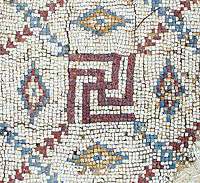
A new hypothesis put forth by the IIT Kharagpur in India states that the Swastika symbol migrated from Ancient India to the Americas via the Tartar Mongoloid route and Kamchatka about 11,000 years ago,[18] explaining the presence of the symbol in the Aztec and Mayan civilisations, and through the Western land route to Finland, Scandinavia, the British Highlands and Europe where the symbol is present in varying shapes of the cruciform. According to Joy Sen, a faculty member and the lead project investigator, "After dividing the world into nine quadrants into which Swastika moved from India, we retracted its footprints and have been able to graphically prove our claim through ancient seals, inscriptions, imprints and religious symbolism in these countries."
European hypotheses of the Swastika are often treated in conjunction with cross symbols in general, such as the sun cross of pagan Bronze Age religion. Beyond its certain presence in the "proto-writing" symbol systems, such as the Vinca script,[19] which appeared during the Neolithic,[20] nothing certain is known about the symbol's origin. There are nevertheless a number of speculative hypotheses. One hypothesis is that the cross symbols and the swastika share a common origin in simply symbolizing the sun. Another hypothesis is that the four arms of the cross represent four aspects of nature - the sun, wind, water, soil. Some have said the four arms of cross are four seasons, where the division for 90-degree sections correspond to the solstices and equinoxes. The Hindus represent it as the Universe in our own spiral galaxy in the fore finger of Lord Vishnu. This carries most significance in establishing the creation of the Universe and the arms as 'kal' or time, a calendar that is seen to be more advanced than the lunar calendar where the seasons drift from calendar year to calendar year. The luni-solar solution for correcting season drift was to intercalate an extra month in certain years to restore the lunar cycle to the solar-season cycle. The Star of David is thought to originate as a symbol of that calendar system, where the two overlapping triangles are seen to form a partition of 12 sections around the perimeter with a 13th section in the middle, representing the 12 and sometimes 13 months to a year. As such, the Christian cross, Jewish hexagram star, and Muslim crescent moon are seen to have their origins in different views regarding which calendar system is preferred for marking holy days. Groups in higher latitudes experience the seasons more strongly, offering more advantage to the calendar represented by the swastika/cross.
According to Reza Assasi, the swastika is a geometric pattern in the sky representing the north ecliptic pole centred to Zeta Draconis. He argues that this primitive astrological symbol was later called the four-horse chariot of Mithra in ancient Iran and represented the centre of Ecliptic in the star map and also demonstrates that in Iranian mythology, the cosmos was believed to be pulled by four heavenly horses revolving around a fixed centre on clockwise direction possibly because of a geocentric understanding of an astronomical phenomenon called axial precession. He suggests that this notion was transmitted to the west and flourished in Roman mithraism in which this symbol appears in Mithraic iconography and astrological representations.[21]
Carl Sagan in his book Comet (1985) reproduces Han period Chinese manuscript (the Book of Silk, 2nd century BC) that shows comet tail varieties: most are variations on simple comet tails, but the last shows the comet nucleus with four bent arms extending from it, recalling a swastika. Sagan suggests that in antiquity a comet could have approached so close to Earth that the jets of gas streaming from it, bent by the comet's rotation, became visible, leading to the adoption of the swastika as a symbol across the world.[22] Bob Kobres in his 1992 paper Comets and the Bronze Age Collapse contends that the swastika like comet on the Han Dynasty silk comet atlas was labeled a "long tailed pheasant star" (Di-Xing) because of its resemblance to a bird's foot or footprint,[23] the latter comparison also being drawn by J.F.K. Hewitt's observation on page 145 of Primitive Traditional History: vol. 1.[24] as well as an article concerning carpet decoration in Good Housekeeping.[25] Kobres goes on to suggest an association of mythological birds and comets also outside China.[23]
In Life's Other Secret (1999), Ian Stewart suggests the ubiquitous swastika pattern arises when parallel waves of neural activity sweep across the visual cortex during states of altered consciousness, producing a swirling swastika-like image, due to the way quadrants in the field of vision are mapped to opposite areas in the brain.[26]
Alexander Cunningham suggested that the Buddhist use of the shape arose from a combination of Brahmi characters abbreviating the words su astí.[10]
Prehistory
The earliest known swastika-like symbol dates from around 10,000-13,000 BC. It appears on a late paleolithic figurine of a bird, carved from mammoth ivory, which was found in Mezine, Ukraine. The bird was found with a number of phallic objects which is consistent with the idea that the swastika pattern was used as a fertility symbol.[27] However it has also been suggested that this swastika may be a stylized picture of a stork in flight and not the true swastika that is in use today.[28] Extensive use of the Swastika can be traced to Ancient India, during the Indus Valley Civilization.


In England, neolithic or Bronze Age stone carvings of the symbol have been found on Ilkley Moor.
Mirror-image swastikas (clockwise and anti-clockwise) have been found on ceramic pottery in the Devetashka cave, Bulgaria, dated 6,000 B.C.[30]
Some of the earliest archaeological evidences of Swastika in the Indian subcontinent can be dated to 3,000 BCE.[31] Swastikas have also been found on pottery in archaeological digs in Africa, in the area of Kush and on pottery at the Jebel Barkal temples,[32] in Iron Age designs of the northern Caucasus (Koban culture), and in Neolithic China in the Majiabang,[33]Majiayao,[34] Dawenkou and Xiaoheyan cultures.[35] Other Iron Age attestations of the swastika can be associated with Indo-European cultures such as the Indo-Iranians, Celts, Greeks, Germanic peoples and Slavs.
The swastika is also seen in Egypt during the Coptic period. Textile number T.231-1923 held at the V&A Museum in London includes small swastikas in its design. This piece was found at Qau-el-Kebir, near Asyut, and is dated between AD300-600.
The Tierwirbel (the German for "animal whorl" or "whirl of animals"[36]) is a characteristic motif in Bronze Age Central Asia, the Eurasian Steppe, and later also in Iron Age Scythian and European (Baltic[37] and Germanic) culture, showing rotational symmetric arrangement of an animal motif, often four birds' heads. Even wider diffusion of this "Asiatic" theme has been proposed, to the Pacific and even North America (especially Moundville).[38]
Historical use
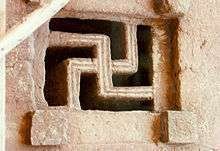
Asia

In Asia, the swastika symbol first appears in the archaeological record around[31] 3000 BCE in the Indus Valley Civilization.[39][40] It also appears in the Bronze and Iron Age cultures around the Black Sea and the Caspian Sea. In all these cultures the swastika symbol does not appear to occupy any marked position or significance, but appears as just one form of a series of similar symbols of varying complexity. In the Zoroastrian religion of Persia, the swastika was a symbol of the revolving sun, infinity, or continuing creation.[41][42] It rose to importance in Buddhism during the Mauryan Empire and in Hinduism with the decline of Buddhism in India during the Gupta Empire. With the spread of Buddhism, the Buddhist swastika reached Tibet and China. The symbol was also introduced to Balinese Hinduism by Hindu kings. The use of the swastika by the Bön faith of Tibet, as well as Chinese Taoism, can also be traced to Buddhist influence. In Thailand, the word "Sawaddi" is normally used as a greeting which simply means "hello"; Sawaddi-ka (feminine) and Sawaddi-krup (masculine). "Sawaddi" derives from the Sanskrit word "swasti" and its meaning is a combination of the words: prosperity, luck, security, glory, and good.
Hinduism
The swastika is an important Hindu symbol. It is traced with the finger with sindoor on the head or body during Hindu religious rites, and on doors on festival days - notably on Diwali. It is painted on many, if not most, three-wheel auto-rikshas and trucks. In all these uses it is a lucky charm protecting from evil and attracting good.
It is also said to represent God (the Brahman) in his universal manifestation, and energy (Shakti). It represents the four directions of the world (the four faces of Brahma). It also represents the Purushartha: Dharma (natural order), Artha (wealth), Kama (desire), and Moksha (liberation).
Among the Hindus of Bengal, it is common to see the name "swastika" (Bengali: স্বস্তিক shostik) applied to a slightly different symbol, which has the same significance as the common swastika, that looks like a stick figure of a human being.[43] Right-facing swastika in the decorative Hindu form is used to evoke the Shakti.
-

Hindu child with head shaven and red Swastika painted on it as part of his Upanayana ceremony.
-

Image of a swastika (স্বস্তিক) from a Bengali wedding invitation printed in 2006
The Arya Samaj is of the opinion that 'Swastik' is 'OM' written in the ancient Brahmi Script.
Buddhism
Buddhism originated in the 5th century BC and spread throughout the Indian subcontinent. The swastika rose in importance around the 3rd century BC (during the Mauryan Empire). Also known as a "yungdrung"[44] in ancient Tibet, it was a graphical representation of eternity.[45]
Jainism
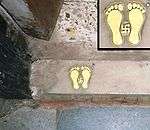
Jainism gives even more prominence to the swastika as a tantra than Buddhism does. It is a symbol of the seventh tīrthaṅkara, Suparśvanātha. In the Śvētāmbara tradition, it is also one of the aṣṭamaṅgala. All Jain temples and holy books must contain the swastika and ceremonies typically begin and end with creating a swastika mark several times with rice around the altar. Jains use rice to make a swastika in front of statues and then put an offering on it, usually a ripe or dried fruit, a sweet (Hindi: मिठाई miṭhāī), or a coin or currency note. The four arms of the swastika symbolize the four places where a soul could be reborn in the cycle of birth and death - svarga "heaven", naraka "hell", manushya "humanity" or tiryancha "as flora or fauna" - before the soul attains moksha "salvation" as a siddha, having ended the cycle of birth and death and become omniscient.[46]
East Asian traditions

The paired swastika symbols are included, at least since the Liao Dynasty (AD 907–1125), as part of the Chinese writing system (卍 and 卐) and are variant characters for 萬 or 万 (wàn in Mandarin, man in Korean, Cantonese, and Japanese, vạn in Vietnamese) meaning "all" or "eternity" (lit. myriad). The swastika marks the beginning of many Buddhist scriptures. In East Asian countries, the left-facing character is often used as symbol for Buddhism and marks the site of a Buddhist temple on maps.
In Chinese, Japanese, and Korean the swastika is also a homonym of the number 10,000, and is commonly used to represent the whole of Creation, e.g. 'the myriad things' in the Dao De Jing. During the Chinese Tang Dynasty, Empress Wu Zetian (684-704) decreed that the swastika would also be used as an alternative symbol of the Sun.
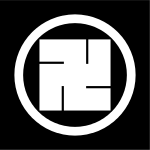
When the Chinese writing system was introduced to Japan in the 8th century, the swastika was adopted into the Japanese language and culture. It is commonly referred as the manji (lit. Man-character). Since the Middle Ages, it has been used as a mon by various Japanese families such as Tsugaru clan, Hachisuka clan or around 60 clans that belong to Tokugawa clan.[47] On Japanese maps, a swastika (left-facing and horizontal) is used to mark the location of a Buddhist temple. The right-facing swastika is often referred to as the gyaku manji (逆卍, lit. "reverse swastika") or migi manji (右卍, lit. "right swastika"), and can also be called kagi jūji (鉤十字, literally "hook cross").
In Chinese and Japanese art, the swastika is often found as part of a repeating pattern. One common pattern, called sayagata in Japanese, comprises left- and right-facing swastikas joined by lines.[48] As the negative space between the lines has a distinctive shape, the sayagata pattern is sometimes called the "key fret" motif in English.
As a pottery graph of unknown provision and meaning the swastika-like sign is known in Chinese Neolithic culture (2400–2000 BCE, Liu wan 柳湾, Qinghai province).
Armenia
In Armenia the swastika is called the "arevakhach" and "kerkhach" (Armenian: կեռխաչ)[49] and is the ancient symbol of eternity and eternal light (i.e. God). Swastikas in Armenia were founded on petroglyphs. During the bronze age it was depicted on cauldrons, belts, medallions and other items.[50] Among the oldest petroglyphs is the seventh letter of the Armenian alphabet - "E" (which means "is" or "to be") - depicted as half-swastika.
Swastikas can also be seen on early Medieval churches and fortresses, including the principal tower in Armenia's historical capital city of Ani.[49] The same symbol can be found on Armenian carpets, cross-stones (khachkar) and in medieval manuscripts, as well as on modern monuments as a symbol of eternity.[51]
Europe
Swastika shapes have been found on numerous artifacts from Iron Age Europe - Armenian arevakhach (Armenian: Արևախաչ, արև arev "sun" + խաչ xač "cross", "sun cross"),[49][52][53] Greco-Roman, Illyrian, Etruscan, Baltic, Celtic, Germanic, and Slavic.[1]
-

Etruscan pendant with swastika symbols, Bolsena, Italy, 700-650 BC. Louvre Museum
-
Svastika on a Roman mosaic in Pula, Croatia
-
Svastika on a Roman mosaic in Veli Brijun, Croatia
Greco-Roman antiquity
Ancient Greek architectural, clothing and coin designs are replete with single or interlinking swastika motifs. There are also gold plate fibulae from the 8th century BC decorated with an engraved swastika.[54] Related symbols in classical Western architecture include the cross, the three-legged triskele or triskelion and the rounded lauburu. The swastika symbol is also known in these contexts by a number of names, especially gammadion,[55] or rather the tetra-gammadion. The name gammadion comes from the fact that it can be seen as being made up of four Greek gamma (Γ) letters. Ancient Greek priestesses would tattoo the symbol, along with the tetraskelion, on their bodies. Ancient Greek architectural designs are replete with the interlinking symbol.
In Greco-Roman art and architecture, and in Romanesque and Gothic art in the West, isolated swastikas are relatively rare, and the swastika is more commonly found as a repeated element in a border or tessellation. The swastika often represented perpetual motion, reflecting the design of a rotating windmill or watermill. A meander of connected swastikas makes up the large band that surrounds the Augustan Ara Pacis.
A design of interlocking swastikas is one of several tessellations on the floor of the cathedral of Amiens, France.[56] A border of linked swastikas was a common Roman architectural motif,[57] and can be seen in more recent buildings as a neoclassical element. A swastika border is one form of meander, and the individual swastikas in such a border are sometimes called Greek keys. There have also been swastikas found on the floors of Pompeii.[58]
-
Bronze Age Mycenaean "doll" with human, solar and tetragammadion (swastika) symbols. Louvre Museum
-

Greek helmet with swastika marks on the top part (circled), 350-325 BC from Taranto, found at Herculanum. Cabinet des Médailles, Paris.
-

Two sauwastikas (opposite-facing swastikas) on an ancient Greek Kantharos, Attica, ca. 780 BC.
Celts
The bronze frontispiece of a ritual pre-Christian (c. 350-50 BC) shield found in the River Thames near Battersea Bridge (hence "Battersea Shield") is embossed with 27 swastikas in bronze and red enamel.[59] An Ogham stone found in Anglish, Co Kerry, Ireland (CIIC 141) was modified into an early Christian gravestone, and was decorated with a cross pattée and two swastikas.[60] The Book of Kells (ca. 800) contains swastika-shaped ornamentation. At the Northern edge of Ilkley Moor in West Yorkshire, there is a swastika-shaped pattern engraved in a stone known as the Swastika Stone.[61]
Germanic Iron Age
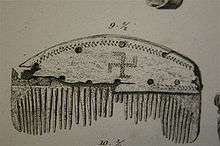
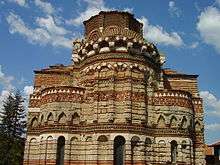
The swastika shape (also called a fylfot) appears on various Germanic Migration Period and Viking Age artifacts, such as the 3rd century Værløse Fibula from Zealand, Denmark, the Gothic spearhead from Brest-Litovsk, today in Belarus, the 9th century Snoldelev Stone from Ramsø, Denmark, and numerous Migration Period bracteates drawn left-facing or right-facing.[62]
The pagan Anglo-Saxon ship burial at Sutton Hoo, England, contained numerous items bearing the swastika, now housed in the collection of the Cambridge Museum of Archaeology and Anthropology.[63] The Swastika is clearly marked on a hilt and sword belt found at Bifrons in Kent, in a grave of about the 6th century.
Hilda Ellis Davidson theorized that the swastika symbol was associated with Thor, possibly representing his hammer Mjolnir - symbolic of thunder - and possibly being connected to the Bronze Age sun cross.[63] Davidson cites "many examples" of the swastika symbol from Anglo-Saxon graves of the pagan period, with particular prominence on cremation urns from the cemeteries of East Anglia.[63] Some of the swastikas on the items, on display at the Cambridge Museum of Archaeology and Anthropology, are depicted with such care and art that, according to Davidson, it must have possessed special significance as a funerary symbol.[63] The runic inscription on the 8th-century Sæbø sword has been taken as evidence of the swastika as a symbol of Thor in Norse paganism.
Illyrians
Swastika was widespread among the Illyrians, symbolizing the Sun. The Sun cult was the main Illyrian cult, and the Sun was represented by a swastika in clockwise motion, and it stood for the movement of the Sun.[64]
Slavic
_Swastika_(%D0%A1%D0%B2%D0%B0%D1%81%D1%82%D0%B8%D0%BA%D0%B0)_-_Rodnovery.jpg)

According to painter Stanisław Jakubowski the "little sun" is an Early Slavic pagan symbol of the sun. It was engraved on wooden monuments built near the final resting places of fallen Slavs to represent eternal life.[65] The symbol was first seen in a collection of Early Slavic symbols and architectural features drawn and compiled by Polish painter Stanisław Jakubowski, which he named Prasłowiańskie motywy architektoniczne (Polish: Early Slavic Architectural Motifs).[65] His work was published in 1923, by a publishing house that was then based in the Dębniki district of Kraków.[65] The symbol can also be found on embroidery and pottery in most Slavic countries.
In Russia before World War I the swastika was a favorite sign of the last Russian Empress Alexandra Feodorovna. She placed it where she could for happiness, including drawing it in pencil on the walls and windows in the Ipatiev House, - place of execution of the royal family, and, without dating, on the wallpaper above the bed, where obviously slept the heir.[66] It was printed on some banknotes of the Russian Provisional Government (1917) and some sovznaks (1918-1922).[67] In 1919 it was approved as insignia for the Kalmyk formations,[68] and for a short period had a certain popularity amongst some artists, politics and army groups.[69] Also it was present on icons, vestments and clerical clothing[70] but in World War II it was removed, becoming by association, a symbol of the German occupation.[71]
In modern Russia some neo-Nazis[72][73] and neopagan followers of pseudohistory argue that the Russian name of the swastika is "Kolovrat" (Russian: Коловрат, lit. "spinning wheel"), but there are no ethnographic sources, confirming this.[71][74] In the traditional vernacular the swastika was called differently; for example, "breeze" - as in Christianity, the swastika represents a spiritual movement, descent of the Holy Spirit, and therefore the "wind" and "spirit" - a word with one meaning.[71] Or "geeses", "ognevtsi" (dialect. "little flames"), "hares" (towel with a swastika was called as towel with the "hares"), "little horses", because it is such a curved cross.[70][71]
The neo-Nazi Russian National Unity group's branch in Estonia is officially registered under the name "Kolovrat" and published an extremist newspaper in 2001 under the same name.[72] A criminal investigation found the paper included an array of racial epithets. One Narva resident was sentenced to 1 year in jail for distribution of Kolovrat.[75] The Kolovrat has since been used by the Rusich Battalion, a Russian militant group known for its operation during the War in Donbass.[76]
The swastika is contained in sign of the Polish nationalist organization Nacjonalistyczne Stowarzyszenie "Zadruga".
Sami
An object very much like a hammer or a double axe is depicted among the magical symbols on the drums of Sami shamans, used in their religious ceremonies before Christianity was established. The name of the Sami thunder god was Horagalles, thought to be derived from "Old Man Thor" (Þórr karl). Sometimes on the drums, a male figure with a hammer-like object in either hand is shown, and sometimes it is more like a cross with crooked ends, or a swastika.[63]
Medieval and early modern Europe
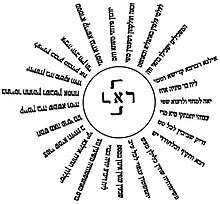
In Christianity, the swastika is used as a hooked version of the Christian Cross, the symbol of Christ's victory over death. Some Christian churches built in the Romanesque and Gothic eras are decorated with swastikas, carrying over earlier Roman designs. Swastikas are prominently displayed in a mosaic in the St. Sophia church of Kiev, Ukraine dating from the 12th century. They also appear as a repeating ornamental motif on a tomb in the Basilica of St. Ambrose in Milan.
A ceiling painted in 1910 in the church of St Laurent in Grenoble has many swastikas. It can be visited today because the church became the archaeological museum of the city. A proposed direct link between it and a swastika floor mosaic in the Cathedral of Our Lady of Amiens, which was built on top of a pagan site at Amiens, France in the 13th century, is considered unlikely. The stole worn by a priest in the 1445 painting of the Seven Sacraments by Rogier van der Weyden presents the swastika form simply as one way of depicting the cross.

Swastikas also appear in art and architecture during the Renaissance and Baroque era. In fact, the famous fresco The School of Athens shows an ornament made out of swastikas, and the symbol can also be found on the facade of the Santa Maria della Salute, a Roman Catholic church and minor basilica located at Punta della Dogana in the Dorsoduro sestiere of the city of Venice.
In the Polish First Republic the symbol of the swastika was also popular with the nobility. According to chronicles, the Rus' prince Oleg, who in the 9th century attacked Constantinople, nailed his shield (which had a large red swastika painted on it) to the city's gates.[77] Several noble houses, e.g. Boreyko, Borzym, and Radziechowski from Ruthenia, also had Swastikas as their coat of arms. The family reached its greatness in the 14th and 15th centuries and its crest can be seen in many heraldry books produced at that time. The Swastika was also a heraldic symbol, for example on the Boreyko coat of arms, used by noblemen in Poland and Ukraine. In the 19th century the swastika was one of the Russian empire's symbols; it was even placed in coins as a background to the Russian eagle.[78][79]
A swastika can be seen on stonework at Valle Crucis Abbey, near Llangollen.
Africa
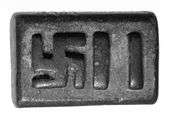
Swastika can be found on Ashanti gold weights and among adinkra symbols in West Africa.[80]
Early 20th century
Swastikas on the wedding dress as symbols of luck, British colony, 1910
In the Western world, the symbol experienced a resurgence following the archaeological work in the late 19th century of Heinrich Schliemann, who discovered the symbol in the site of ancient Troy and associated it with the ancient migrations of Proto-Indo-Europeans, whose proto-language was not incidentally termed "Proto-Indo-Germanisch" by German language historians. He connected it with similar shapes found on ancient pots in Germany, and theorized that the swastika was a "significant religious symbol of our remote ancestors", linking Germanic, Greek and Indo-Iranian cultures.[81][82] By the early 20th century, it was used worldwide and was regarded as a symbol of good luck and success.
The work of Schliemann soon became intertwined with the völkisch movements, for which the swastika was a symbol of the "Aryan race", a concept that came to be equated by theorists such as Alfred Rosenberg with a Nordic master race originating in northern Europe. Since its adoption by the Nazi Party of Adolf Hitler, the swastika has been associated with Nazism, fascism, racism in its (white supremacy) form, the Axis powers in World War II, and the Holocaust in much of the West. The swastika remains a core symbol of Neo-Nazi groups.
The Benedictine choir school at Lambach Abbey, Upper Austria, which Hitler attended for several months as a boy, had a swastika chiseled into the monastery portal and also the wall above the spring grotto in the courtyard by 1868. Their origin was the personal coat of arms of Abbot Theoderich Hagn of the monastery in Lambach, which bore a golden swastika with slanted points on a blue field.[83] The Lambach swastika is probably of Medieval origin.
Europe
Britain

In the 1880's the Theosophical Society adopted a swastika as part of its seal, along with an Om, a hexagram or star of David, an Ankh and an Ouroboros. Unlike the much more recent Raëlian movement, the Theosophical Society symbol has been free from controversy, and the seal is still used. The current seal also includes the text "There is no religion higher than truth."[84]
Denmark

The Danish brewery company Carlsberg Group used the swastika as a logo[85] from the 19th Century until the middle of the 1930s when it was discontinued because of association with the Nazi Party in neighbouring Germany. The swastika carved on elephants at the entrance gates of the company's headquarters in Copenhagen in 1901 can still be seen today.[86]
Ireland
The Swastika Laundry was a laundry founded in 1912, located on Shelbourne Road, Ballsbridge, a district of Dublin, Ireland. In the fifties Heinrich Böll came across a van belonging to the company while he was staying in Ireland, leading to some awkward moments before he realized the company was older than Nazism and totally unrelated to it. The chimney of the boiler-house of the laundry still stands, but the laundry has been redeveloped.[87][88]
Finnish folklore
In Finland the swastika was often used in traditional folk art products, as a decoration or magical symbol on textiles and wood. The swastika was also used by the Finnish Air Force until 1945, and is still used in air force flags.
The tursaansydän is used by scouts in some instances[89] and a student organization.[90] The village of Tursa uses the tursaansydän as a kind of a certificate of authenticity on products made there.[91] Traditional textiles are still being made with swastikas as parts of traditional ornaments.
Swastika in Finnish military


The Finnish Air Force used the swastika as an emblem, introduced in 1918. The type of swastika adopted by the air-force was the symbol of luck for the Swedish count Eric von Rosen, who donated one of its earliest aircraft; he later became a prominent figure in the Swedish nazi-movement.
The swastika was also used by the women's paramilitary organization Lotta Svärd, which was banned in 1944 in accordance with the Moscow Armistice between Finland and the allied Soviet Union and Britain.
The President of Finland is the grand master of the Order of the White Rose. According to the protocol, the president shall wear the Grand Cross of the White Rose with collar on formal occasions. The original design of the collar, decorated with 9 swastikas, dates from 1918, and was designed by the artist Akseli Gallen-Kallela. The Grand Cross with the swastika collar has been awarded 41 times to foreign heads of state. To avoid misunderstandings, the swastika decorations were replaced by fir crosses at the decision of president Urho Kekkonen in 1963 after it became known that the President of France Charles De Gaulle was uncomfortable with the swastika collar.
Also a design by Gallen-Kallela from 1918, the Cross of Liberty has a swastika pattern in its arms. The Cross of Liberty is depicted in the upper left corner of the standard of the President of Finland.[92]
In December 2007, a silver replica of the World War II period Finnish air defence's relief ring decorated with a swastika became available as a part of a charity campaign.[93]
The original war time idea was that the public swap their precious metal rings for the State air defence's relief ring, made of iron.
Latvia
Latvia adopted the swastika, called the Ugunskrusts ("fire cross"), for its air force in 1918/1919 and continued its use until 1940. The cross itself was maroon on a white background, mirroring the colors of the Latvian flag. Earlier versions pointed counter-clockwise, while later versions pointed clock-wise and eliminated the white background.[94][95]
Poland
The traditional symbols of the Podhale Rifles include the edelweiss flower and the Mountain Cross, a swastika symbol popular in folk culture of the Polish mountainous regions. The units of Podhale Rifles, both historical and modern, are notable for their high morale and distinctive uniforms.
North America


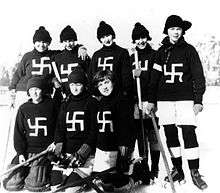
.svg.png)
The swastika motif is found in some traditional Native American art and iconography. Historically, the design has been found in excavations of Mississippian-era sites in the Ohio and Mississippi River valleys, and on objects associated with the Southeastern Ceremonial Complex (S.E.C.C.). It is also widely used by a number of southwestern tribes, most notably the Navajo, and plains nations such as the Dakota. Among various tribes, the swastika carries different meanings. To the Hopi it represents the wandering Hopi clan; to the Navajo it is one symbol for the whirling log (tsil no'oli), a sacred image representing a legend that is used in healing rituals.[96] A brightly colored First Nations saddle featuring swastika designs is on display at the Royal Saskatchewan Museum in Canada.[97]
A swastika shape is a symbol in the culture of the Kuna people of Kuna Yala, Panama. In Kuna tradition it symbolizes the octopus that created the world, its tentacles pointing to the four cardinal points.[98]
In February 1925 the Kuna revolted vigorously against Panamanian suppression of their culture, and in 1930 they assumed autonomy. The flag they adopted at that time is based on the swastika shape, and remains the official flag of Kuna Yala. A number of variations on the flag have been used over the years: red top and bottom bands instead of orange were previously used, and in 1942 a ring (representing the traditional Kuna nose-ring) was added to the center of the flag to distance it from the symbol of the Nazi party.[99]
The symbol for the 45th Infantry Division of the United States Army, before the 1930s, was a red square with a yellow swastika, a tribute to the large Native American population in the southwestern United States.
The town of Swastika, Ontario, Canada is named after the symbol.
Nazism
Use in Nazism
.svg.png)
In the wake of widespread popular usage, the Nazi Party (Nationalsozialistische Deutsche Arbeiterpartei or NSDAP) formally adopted the swastika (in German: Hakenkreuz (pronounced more or less "HAHK-en-KROITS" meaning "hooked-cross") in 1920. This was used on the party's flag, badge, and armband.
In his 1925 work Mein Kampf, Adolf Hitler writes that: "I myself, meanwhile, after innumerable attempts, had laid down a final form; a flag with a red background, a white disk, and a black swastika in the middle. After long trials I also found a definite proportion between the size of the flag and the size of the white disk, as well as the shape and thickness of the swastika."
When Hitler created a flag for the Nazi Party, he sought to incorporate both the swastika and "those revered colors expressive of our homage to the glorious past and which once brought so much honor to the German nation." (Red, white, and black were the colors of the flag of the old German Empire.) He also stated: "As National Socialists, we see our program in our flag. In red, we see the social idea of the movement; in white, the nationalistic idea; in the swastika, the mission of the struggle for the victory of the Aryan man, and, by the same token, the victory of the idea of creative work."[100]
The swastika was also understood as "the symbol of the creating, effecting life" (das Symbol des schaffenden, wirkenden Lebens) and as "race emblem of Germanism" (Rasseabzeichen des Germanentums).[101]
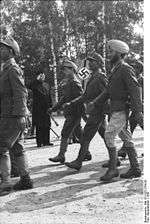
The use of the swastika was incorporated by Nazi theorists with their conjecture of Aryan cultural descent of the German people. Following the Nordicist version of the Aryan invasion theory, the Nazis claimed that the early Aryans of India, from whose Vedic tradition the swastika sprang, were the prototypical white invaders. The concept of racial hygiene was an ideology central to Nazism, though it is scientific racism.[102][103] For Alfred Rosenberg, the Aryans of India were both a model to be imitated and a warning of the dangers of the spiritual and racial "confusion" that, he believed, arose from the proximity of races. Thus, they saw fit to co-opt the sign as a symbol of the Aryan master race. The use of the swastika as a symbol of the Aryan race dates back to writings of Emile Burnouf. Following many other writers, the German nationalist poet Guido von List believed it to be a uniquely Aryan symbol.

Before the Nazis, the swastika was already in use as a symbol of German völkisch nationalist movements (Völkische Bewegung). Ulric of England [sic] says
... what inspired Hitler to use the swastika as a symbol for the NSDAP was its use by the Thule Society (German: Thule-Gesellschaft) since there were many connections between them and the DAP ... from 1919 until the summer of 1921 Hitler used the special Nationalsozialistische library of Dr. Friedrich Krohn, a very active member of the Thule-Gesellschaft ... Dr. Krohn was also the dentist from Sternberg who was named by Hitler in Mein Kampf as the designer of a flag very similar to one that Hitler designed in 1920 ... during the summer of 1920, the first party flag was shown at Lake Tegernsee ... these home-made ... early flags were not preserved, the Ortsgruppe München (Munich Local Group) flag was generally regarded as the first flag of the Party.— Ulric of England, Deutschland Erwache, ISBN 0-912138-69-6
José Manuel Erbez says:
The first time the swastika was used with an Aryan meaning was on December 25, 1907, when the self-named Order of the New Templars, a secret society founded by [Adolf Joseph] Jörg Lanz von Liebenfels, hoisted at Werfenstein Castle (Austria) a yellow flag with a swastika and four fleurs-de-lys.[104]
However, Liebenfels was drawing on an already established use of the symbol. On March 14, 1933, shortly after Hitler's appointment as Chancellor of Germany, the NSDAP flag was hoisted alongside Germany's national colors. It was adopted as the sole national flag on September 15, 1935.
The swastika was used for badges and flags throughout Nazi Germany, particularly for government and military organizations, but also for "popular" organizations such as the Reichsbund Deutsche Jägerschaft (German Hunting Society).[105]
While the DAP and the NSDAP had used both right-facing and left-facing swastikas, the right-facing swastika was used consistently from 1920 onwards. Ralf Stelter notes that the swastika flag used on land had a right-facing swastika on both sides, while the ensign (naval flag) had it printed through so that a left-facing swastika would be seen when looking at the ensign with the flagpole to the right.[106] Nazi ensigns had a through and through image, so both versions were present, one on each side, but the Nazi flag on land was right-facing on both sides and at a 45° rotation.[107]
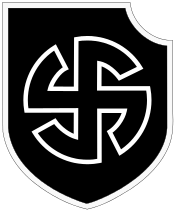

Several variants are found:
- a 45° black swastika on a white disc as in the NSDAP and national flags;
- a 45° black swastika on a white lozenge (Hitler Youth[108]);
- a 45° black swastika with a white outline was painted on the tail of aircraft of the Luftwaffe, and usually using a design based on a 25-small-square subdivided square template (width of "strokes" in each of its arms, equalling the width of the space between the strokes);
- a 45° black swastika outlined by thin white and black lines on a white disc (the German War Ensign[109]);
- an upright black swastika outlined by thin white and black lines on a white disc ( Personal standard of Adolf Hitler in which a gold wreath encircles the swastika; the Schutzstaffel; and the Reichsdienstflagge, in which a black circle encircles the swastika);
- small gold, silver, black, or white 45° swastikas, often lying on or being held by an eagle, on many badges and flags.[110]
- a swastika with curved outer arms forming a broken circle, as worn by the Waffen SS Wiking and Nordland Divisions.[111]
There were attempts to amalgamate Nazi and Hindu use of the swastika, notably by the French writer Savitri Devi who declared Hitler an Avatar of Vishnu.
Use by anti-Nazis

During World War II it was common to use small swastikas to mark air-to-air victories on the sides of Allied aircraft, and at least one British fighter pilot inscribed a swastika in his logbook for each German plane he shot down in World War II.[112]
Post-World War II stigmatization
Origins
Because of its use by Nazi Germany, the swastika since the 1930s has been largely associated with Nazism and white supremacy in most Western countries.
As a result, all of its use, or its use as a Nazi or hate symbol, is prohibited in some countries, including Germany. Because of the stigma attached to the symbol, many buildings that have used the symbol as decoration have had the symbol removed.
Germany
The German and Austrian postwar criminal code makes the public showing of the Hakenkreuz (the swastika), the sig rune, the Celtic cross (specifically the variations used by the White-Power-Activists), the wolfsangel, the odal rune and the Totenkopf skull illegal, except for scholarly reasons (and - in the case of the odal rune - as the insignia of the rank of sergeant major, Hauptfeldwebel,[113] in the modern German Bundeswehr). It is also censored from the reprints of 1930s railway timetables published by the Reichsbahn. The eagle remains, but appears to be holding a solid black circle between its talons. The swastikas on Hindu, Buddhist, and Jain temples are exempt, as religious symbols cannot be banned in Germany.
The German fashion company Esprit Holdings was investigated for using traditional British-made folded leather buttons after complaints that they resembled swastikas. In response, Esprit Holdings destroyed two hundred thousand catalogues.[114][115]
A controversy was stirred by the decision of several police departments to begin inquiries against anti-fascists.[116] In late 2005 police raided the offices of the punk rock label and mail order store "Nix Gut Records" and confiscated merchandise depicting crossed-out swastikas and fists smashing swastikas. In 2006 the Stade police department started an inquiry against anti-fascist youths using a placard depicting a person dumping a swastika into a trashcan. The placard was displayed in opposition to the campaign of right-wing nationalist parties for local elections.[117]
On Friday, March 17, 2006, a member of the Bundestag, Claudia Roth reported herself to the German police for displaying a crossed-out swastika in multiple demonstrations against Neo-Nazis, and subsequently got the Bundestag to suspend her immunity from prosecution. She intended to show the absurdity of charging anti-fascists with using fascist symbols: "We don't need prosecution of non-violent young people engaging against right-wing extremism." On March 15, 2007, the Federal Court of Justice of Germany (Bundesgerichtshof) held that the crossed-out symbols were "clearly directed against a revival of national-socialist endeavors", thereby settling the dispute for the future.[118][119][120]
Legislation in other European countries
- In Hungary, it is a criminal misdemeanour to publicly display "totalitarian symbols", including the swastika, the SS insignia, and the Arrow Cross, punishable by a fine.[121] Display for academic, educational, artistic or journalistic reasons is allowed. The communist symbols of hammer and sickle and the red star are also regarded as totalitarian symbols and have the same restriction by Hungarian criminal law.
- In Lithuania, public display of Nazi and Soviet symbols, including the Nazi swastika, is an administrative offence, punishable by a fine from 150 to 300 euros. According to judicial practice, display of a non-Nazi swastika is legal.[122]
- In Poland, public display of Nazi symbols, including the Nazi swastika, is a criminal offence punishable by up to eight years of imprisonment. The use of the swastika as a religious symbol is legal.[123]
Attempt to ban in the European Union
The European Union's Executive Commission proposed a European Union-wide anti-racism law in 2001, but European Union states failed to agree on the balance between prohibiting racism and freedom of expression.[124] An attempt to ban the swastika across the EU in early 2005 failed after objections from the British Government and others. In early 2007, while Germany held the European Union presidency, Berlin proposed that the European Union should follow German Criminal Law and criminalize the denial of the Holocaust and the display of Nazi symbols including the swastika, which is based on the Ban on the Symbols of Unconstitutional Organizations Act. This led to an opposition campaign by Hindu groups across Europe against a ban on the swastika. They pointed out that the swastika has been around for 5,000 years as a symbol of peace.[125][126] The proposal to ban the swastika was dropped by Berlin from the proposed European Union wide anti-racism laws on January 29, 2007.[124]
Latin America
- The manufacture, distribution or broadcasting of the swastika, with the intent to propagate Nazism, is a crime in Brazil as dictated by article 20, paragraph 1, of federal statute 7.716, passed in 1989. The penalty is a two to five years prison term and a fine.[127]
- The flag of the Guna Yala autonomous territory of Panama is based on a swastika design. In 1942 a ring was added to the centre of the flag to differentiate it from the symbol of the Nazi Party (this version subsequently fell into disuse).[99]
Media
In 2010, Microsoft officially spoke out against the use of the swastika in the first-person shooter Call of Duty: Black Ops. In Black Ops, players are allowed to customize their name tags to represent, essentially, whatever they want. The swastika can be created and used, but Stephen Toulouse, director of Xbox Live policy and enforcement, stated that players with the symbol on their name tag will be banned (if someone reports as inappropriate) from Xbox Live.[128]
In the Indiana Jones Stunt Spectacular in Disney Hollywood Studios in Orlando, Florida, the swastikas on German trucks, aircraft and actor uniforms in the reenactment of a scene from Raiders of the Lost Ark were removed in 2004. The swastika has been replaced by a stylized Greek Cross.[129]
Nazi imagery was adapted and incorporated into the 2016 sci-fi movie 2BR02B: To Be or Naught to Be. Its inclusion was to subliminally draw parallels between the movie's Federal Bureau of Termination and Nazi Germany, and also refer to Kurt Vonnegut's experiences as a POW and the influence World War II played in his imagining of a population-controlled future where gas chambers are used to terminate people. The Federal Bureau of Termination logo appears as a white geometric design with a black outline, centered on vertical banners, in reference to the Third Reich banners. These banners were initially red, until crew felt the allusion was too strong. The movie's hospital was envisaged as the Bureau's branch which controlled birth, and their red cross was given 'wings' to transform it into a swastika, and link it to the Bureau's logo.[130]
Postwar use
Contemporary use in Asia
Central Asia
In 2005, authorities in Tajikistan called for the widespread adoption of the swastika as a national symbol. President Emomali Rahmonov declared the swastika an Aryan symbol and 2006 to be "the year of Aryan culture", which would be a time to "study and popularize Aryan contributions to the history of the world civilization, raise a new generation (of Tajiks) with the spirit of national self-determination, and develop deeper ties with other ethnicities and cultures".[131]
East Asia
.jpg)
In the Sinosphere, countries and regions that were historically influenced by the culture of China, such as Taiwan, Japan, Hong Kong, Korea, Vietnam, Singapore and China itself, the symbol is most commonly associated with Buddhism.
They are commonly found in Buddhist temples, religious artifacts, texts related to Buddhism and schools founded by Buddhist religious groups.

The Red Swastika Society, a syncretic religious group that aspires to unify Taoism, Confucianism, and Buddhism, runs two schools in Hong Kong (Hong Kong Red Swastika Society Tai Po Secondary School[132] and Hong Kong Red Swastika Society Tuen Mun Primary School[133] ) and one in Singapore (Red Swastika School). All of them incorporated the Swastika in their school logo to signify the society's aspiration with philanthropy and moral education.
The swastika is also used in maps to denote a temple. For example, the symbol is designated by the Survey Act and related Japanese governmental rules to denote a Buddhist temple on Japanese maps.[134]
Hirosaki City in Aomori Prefecture designates this symbol as its official flag, which stemmed from its use in the emblem of Tsugaru clan, the lord of Hirosaki Domain in Edo era.
Indian Subcontinent

In Indian Subcontinent, the swastika is omnipresent as a symbol of wealth and good fortune. In India and Nepal, electoral ballot papers are stamped with a round swastika-like pattern (to ensure that the accidental ink imprint on the other side of a folded ballot paper can be correctly identified as such).[135] Many businesses and other organisations, such as the Ahmedabad Stock Exchange and the Nepal Chamber of Commerce,[136] use the swastika in their logos. The red swastika was suggested as an emblem of International Red Cross and Red Crescent Movement in India and Sri Lanka, but the idea was not implemented.[137] Swastikas are fairly ubiquitous in Indian and Nepalese cities, located on buses, buildings, auto-rickshaws, and clothing. The swastika continues to be prominently used in Hindu religious ceremonies and temples, and is recognised as a Hindu religious symbol, sometimes used to evoke the Shakti in tantric rituals.

Musaeus College in Colombo, Sri Lanka which is a popular Buddhist girls' school in the country has a left facing swastika in their school logo alongside the Sanskrit motto පදීපං ගවේසථ" (pronounced: "padeepang gavae saTha") which means "Follow the Light".
In India, Swastik and Swastika, with their spelling variants, are common first names for males and females respectively, e.g. Swastika Mukherjee. Also, the Seal of Bihar contains two swastikas.
Western misinterpretation of Asian use
At the end of 20th century, and early 21st century, confusion and controversy has occurred when consumer goods bearing the Buddhist symbol have been exported to North America, and mistakenly interpreted by Western consumers as a Nazi symbol.
When a ten-year-old boy in Lynbrook, New York, bought a set of Pokémon cards imported from Japan in 1999, two of the cards contained the left-facing Buddhist swastika. The boy's parents misinterpreted the symbol as a Nazi swastika, which is right-facing with 45 degree rotation, and filed a complaint to the manufacturer. Nintendo of America announced that the cards would be discontinued, explaining that what was acceptable in one culture was not necessarily so in another; their action was welcomed by the Anti-Defamation League who recognised that there was no intention to be offensive but said that international commerce meant that "isolating [the Swastika] in Asia would just create more problems".[138]
In 2002, Christmas crackers containing plastic toy red pandas sporting swastikas were pulled from shelves after complaints from consumers in Canada. The manufacturer, based in China, said the symbol was presented in a traditional sense and not as a reference to the Nazis, and apologized to the customers for the cross-cultural mixup.[139] In 2007, Spanish fashion chain Zara withdrew a handbag from its stores after a customer in Britain complained swastikas were embroidered on it. The bags were made by a supplier in India and inspired by commonly used Hindu symbols, which include the swastika.[140]
New religious movements
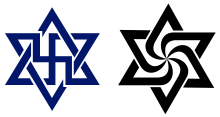
Besides the use as a religious symbol in Buddhism, Hinduism and Jainism, which can be traced to pre-modern traditions, the swastika is also used by a number of new religious movements established in the modern period.
- The Raëlian Movement, who believe that Extra-Terrestrials originally created all life on earth, use a symbol that is often the source of considerable controversy: an interlaced star of David and a swastika. The Raelians state that the Star of David represents infinity in space whereas the swastika represents infinity in time - no beginning and no end in time and everything being cyclic.[141] In 1991, the symbol was changed to remove the swastika, out of respect to the victims of the Holocaust, but as of 2007 has been restored to its original form.[142]
- The Tantra-based movement Ananda Marga (Devanagari: आनन्द मार्ग, meaning Path of Bliss) uses a motif similar to the Raëlians, but in their case the apparent star of David is defined as intersecting triangles with no specific reference to Jewish culture.
- The Falun Gong qigong movement uses a symbol that features a large swastika surrounded by four smaller (and rounded) ones, interspersed with yin-and-yang symbols. The usage is taken from traditional Chinese symbolism, and here alludes to a chakra-like portion of the esoteric human anatomy, located in the stomach.
- The Odinic Rite claims the fylfot as a holy symbol of Odinism, citing the pre-Christian Germanic use of the symbol.
See also
- Armenian eternity sign
- Borjgali
- Brigid's cross
- Camunian rose
- Fascist symbolism
- Nazi mysticism
- Sun cross
- Swastika curve
- Triskelion
References
- 1 2 3 "The Migration of Symbols Index".
- ↑ Press, Cambridge University (10 April 2008). "Cambridge Advanced Learner's Dictionary". Cambridge University Press – via Google Books.
- ↑ Beer, Robert (1 January 2003). "The Handbook of Tibetan Buddhist Symbols". Serindia Publications, Inc. – via Google Books.
- 1 2 ""Swastika" Etymology". dictionary.com. Retrieved 8 June 2015.
- ↑ "Ganesh Puran" and other riligious texts from the 'Sanatan Dharma'
- ↑ Rosenberg, Jennifer. "History of Swastika". about.com. Retrieved 26 April 2013.
- ↑ http://www.bbc.com/news/magazine-29644591
- ↑ first recorded 1871 (OED); alternative historical English spellings include suastika, swastica, and svastica.
- ↑ "svasti meaning". www.sanskritdictionary.com. Retrieved 6 June 2014.
- 1 2 Monier Monier-Williams (1899). A Sanskrit-English Dictionary, s.v. svastika (p. 1283).
- ↑ "Tetraskelion Definition and Origin". Merriam-Webster Inc. Retrieved 5 August 2015.
- ↑ "Melissa Cody's Whirling Logs: Don't You Dare Call Them Swastikas". ICTMN.com. August 7, 2013.
- ↑ "Swastika Flag Specifications and Construction Sheet (Germany)". Flags of the World.
- ↑ ""CJK Unified Ideographs"" (PDF). (4.83 MB), The Unicode Standard, Version 4.1. Unicode, Inc. 2005.
- ↑ Big5: C9_C3, according to Wenlin
- ↑ Big5+: 85_80, according to Wenlin
- ↑ "Right-Facing Svasti Sign" (click "next" 3 times)
- ↑
- ↑ Paliga S., The tablets of Tǎrtǎria Dialogues d'histoire ancienne, vol. 19, n°1, 1993. pp. 9-43; (Fig.5 on p.28)
- ↑ Freed, S. A. and R. S., "Origin of the Swastika", Natural History, January 1980, 68-75.
- ↑ Assasi, Reza. 2013. Swastika:The Forgotten Constellation Representing the Chariot of Mithras. In: Ivan Šprajc and Peter Pehani Ed. ANCIENT COSMOLOGIES AND MODERN PROPHETS: Proceedings of the 20th Conference of the European Society for Astronomy in Culture (Special volume of Anthropological Notebooks) Ljubljana: Slovene Anthropological Society. p418. ISSN 1408-032X
- ↑ Sagan, Carl; Ann Druyan (1985). Comet. Ballantine Books. p. 496. ISBN 0-345-41222-2.
- 1 2 Kobres, Bob. "Comets and the Bronze Age Collapse".
- ↑ Hewitt, J.F.K. (1907). Primitive Traditional History: The Primitive History and Chronology of India, South-eastern and South-western Asia, Egypt, and Europe, and the Colonies Thence Sent Forth. 1. J. Parker and Company.
- ↑ Good Housekeeping. 47. C. W. Bryan & Company. 1908.
- ↑ Stewart, Ian (1999). Life's Other Secret: The new mathematics of the living world. Penguin.
- ↑ Mukti Jain Campion: How the world loved the swastika - until Hitler stole it BBC 23 October 2014
- ↑ Campbell, Joseph (2002). The Flight of the Wild Gander. p. 117.
- ↑ Stanley A. Freed, Research Pitfalls as a Result of the Restoration of Museum Specimens, Annals of the New York Academy of Sciences, Volume 376, The Research Potential of Anthropological Museum Collections pages 229–245, December 1981.
- ↑ Dimitrova, Stefania "8 000 Year Ago Proto-Thracians Depicted the Evolution of the Divine"
- 1 2 Kathleen M. Nadeau (2010). Lee, Jonathan H. X., ed. Encyclopedia of Asian American Folklore and Folklife. ABL-CLIO. p. 87. ISBN 978-0-313-35066-5. Retrieved 21 March 2011.
- ↑ Dunham, Dows "A Collection of 'Pot-Marks' from Kush and Nubia", Kush, 13, 131-147, 1965
- ↑ (Chinese) Bao Jing " “卍”与“卐”漫议 ("卍""and "卐" Man Yee)". 2004-01-06, news.xinhuanet.com
- ↑ "Jar with swastika design Majiayao culture, Machang type (Gansu or Qinghai province)". Daghlian Collection of Chinese Art
- ↑ (Chinese) "卍字符號 (Swastika Symbol). Epoch Times, 2009-04-22 Reprint from New Era #115 "Art and Culture" section (2009.04.02—04.08)
- ↑ a term coined by Anna Roes, "Tierwirbel", IPEK, 1936-37
- ↑ Marija Gimbutas The Balts before the Dawn of History
- ↑ Claude Lévi-Strauss, Structural Anthropology (1959), p. 267.
- ↑ Steven Heller. The Swastika: Symbol Beyond Redemption?. Skyhorse Publishing, Inc. p. 31.
- ↑ Mohan Pant, Shūji Funo. Stupa and Swastika: Historical Urban Planning Principles in Nepal's Kathmandu Valley. NUS Press. p. 16.
- ↑ Dictionary - Definition of swastika
- ↑ Druid, Morning Star Athbhreith Athbheochan Kwisatz Haderach. "A symbol is a thought, a drawing, an action, an archetype, etcetera of the conceptualization of a thing that exists either in reality or in the imagination.". horizontal tab character in
|title=at position 69 (help) - ↑ However the same figure of human is also commonly called "Vasudha" or Basudha - meaning the "Mother Earth"Shubho Nabobarsho". Bengal on the Net. April 16, 2001
- ↑ "what-is-yungdrung". Retrieved 7 June 2009.
- ↑ "About the Bon". Retrieved 7 June 2009.
- ↑ Cort 2001, p. 17.
- ↑ (Japanese) Hitoshi Takazawa, Encyclopedia of Kamon, Tōkyōdō Shuppan, 2008. ISBN 978-4-490-10738-8.
- ↑ "Sayagata 紗綾形". Japanese Architecture and Art Net Users System.
- 1 2 3 Concise Armenian Encyclopedia, Yerevan, v. II, p. 663
- ↑ T. Wilson The swastika, the earlist known symbol and its migrations, p. 807, 951
- ↑ Armenia.
- ↑ Jacob G. Ghazarian (2006), The Mediterranean legacy in early Celtic Christianity: a journey from Armenia to Ireland, Bennett & Bloom, pp. 263, p. 171 "... Quite a different version of the Celtic triskelion, and perhaps the most common pre-Christian symbolism found throughout Armenian cultural tradition, is the round clockwise (occasionally counter-clockwise) whirling sun-like spiral fixed at a centre — the Armenian symbol of eternity."
- ↑ K. B. Mehr, M. Markow, Mormon Missionaries enter Eastern Europe, Brigham Young University Press, 2002, pp. 399, p. 252 "... She viewed a tall building with spires and circular windows along the top of the walls. It was engraved with sun stones, a typical symbol of eternity in ancient Armenian architecture."
- ↑ Biers, W.R. 1996. The Archaeology of Greece, p. 130. Cornell University Press, Ithaca/London.
- ↑ "Perseus:image:1990.26.0822". Perseus.tufts.edu. 1990-02-26. Retrieved 2 March 2010.
- ↑ Robert Ferré. "Amiens Cathedral". Labyrinth Enterprises. Constructed from 1220 to 1402, Amiens Cathedral is the largest Gothic cathedral in France, a popular tourist attraction and since 1981 a UNESCO World Heritage Site. During World War I, Amiens was targeted by German forces but remained in Allied territory following the Battle of Amiens.
- ↑ Gary Malkin. "Tockington Park Roman Villa". The Area of Bristol in Roman Times. December 9, 2002.
- ↑ Lara Nagy, Jane Vadnal, "Glossary Medieval Art and Architecture", "Greek key or meander", University of Pittsburgh 1997-98.
- ↑ The Battersea Shield British Museum
- ↑ "CISP entry". Ucl.ac.uk. Retrieved 2 March 2010.
- ↑ Martin J Powell. "Megalithic Sites in England - Photo Archive".
- ↑ Margrethe, Queen, Poul Kjrum, Rikke Agnete Olsen (1990). Oldtidens Ansigt: Faces of the Past, page 148. ISBN 978-87-7468-274-5
- 1 2 3 4 5 H.R. Ellis Davidson (1965). Gods and Myths of Northern Europe, page 83. ISBN 978-0-14-013627-2, p. 83
- ↑ Stipčević, Aleksandar (1977). The Illyrians: history and culture. Noyes Press. pp. 182, 186. ISBN 9780815550525.
- 1 2 3 "Prasłowiańskie motywy architektoniczne". 1923. Retrieved 19 May 2014.
- ↑ Pierre Gilliard. Тринадцать лет при русском дворе = Thirteen Years at the Russian Court. — М.: «Захаров», 2006. — ISBN 5-8159-0566-6. — p. 175.
- ↑ Николаев Р. Советские «кредитки» со свастикой? (in Russian) // «Миниатюра» 1992 №7, с. 11. archived
- ↑ s:ru:Приказ войскам Юго-Восточного фронта от 03.11.1919 № 213, Степанов Алексей. Красный калейдоскоп гражданской войны. Калмыцкие формирования. 1919 - 1921 // Цейхгауз. - 1995 - № 4 - С. 43
- ↑ Вольфганг Акунов. Барон фон Унгерн — белый бог войны
- 1 2 Багдасаров Р. В. (2002). "Русские имена свастики". Свастика: священный символ. Этнорелигиоведческие очерки (in Russian) (2nd ed.). Moskow: Белые Альвы. ISBN 5-7619-0164-1.
- 1 2 3 4 Багдасаров, Роман. "Свастика: благословение или проклятие". "Цена Победы". "Echo of Moscow". Archived from the original on 2011-08-23. Retrieved 2010-04-07.
- 1 2 Вячеслав Лихачев. Нацизм в России. с.5 - about symbolic of neo-nazy party "RNU"
- ↑ McKay, George. Subcultures and New Religious Movements in Russia and East-Central Europe. p. 282.
- ↑ Trubachyov, Oleg, ed. (1983). "Kolovortъ; кolovьrtъ" (PDF). Etymological dictionary of Slavic languages (in Russian). 10. Moskow: Nauka. pp. 149, 150.
- ↑ Mudde, Cas. Racist Extremism in Central and Eastern Europe. p. 61.
- ↑ http://www.theinsider.ua/politics/55cdd8ccea6a8/
- ↑ "Swastika (Kolovrat) - Historical Roots" (in Russian). Distedu.ru. Retrieved 2 March 2010.
- ↑ Vladimir Nikolaevich. "The Swastika, the historical roots" (in Russian). Klk.pp.ru. Retrieved 2 March 2010.
- ↑ Vladimir Plakhotnyuk. "Kolovrat-Historical Roots-Collection of articles" (in Russian). Ruskolan.xpomo.com. Retrieved 2 March 2010.
- ↑ Claire Polakoff. Into Indigo: African Textiles and Dyeing Techniques. 1980
- ↑ Schliemann, H, Troy and its remains, London: Murray, 1875, pp. 102, 119-20.
- ↑ Boxer, Sarah (2000-06-29). "One of the World's Great Symbols Strives for a Comeback". Think Tank. The New York Times. Retrieved 7 May 2012.
- ↑ Dutch article in Wikipedia "Swastika"; Holocaust Chronology
- ↑ "Emblem or the Seal - TS Adyar".
- ↑ "Flickr Album; "Probably the Best Photo's of Swastikas in the World"". Fiveprime.org. Retrieved 1 May 2011.
- ↑ Carlsberg Group Website
- ↑ "Swastika chimney". The Irish Times. 2007-03-03. Archived from the original on 20 May 2011. Retrieved 3 October 2010.
- ↑ "Swastika Laundry (1912–1987)". Come here to me!. Comeheretome.wordpress.com. 2010-04-26. Retrieved 3 October 2010.
- ↑ "Partiolippukunta Pitkäjärven Vaeltajat ry". Pitva.partio.net. Retrieved 2 March 2010.
- ↑ Kainuun Kerho (2009-09-18). "Kainuun Kerho". Ppo.osakunta.fi. Retrieved 2 March 2010.
- ↑ "Tursan Sydän". Tursa.fi. Retrieved 2 March 2010.
- ↑ Flag The President of the Republic Of Finland
- ↑ "Campaign site rautasormus.fi (campaign now closed)". Rautasormus.fi. Retrieved 2 March 2010.
- ↑ Latvian Air Force 1918-40. Retrieved 30 September 2008.
- ↑ Spārnota Latvija. Retrieved 30 September 2008.
- ↑ Dottie Indyke. "The History of an Ancient Human Symbol". April 4, 2005. originally from The Wingspread Collector's Guide to Santa Fe, Taos and Albuquerque, Volume 15.
- ↑ Photo and text,"Why is there a Swastika on the saddle in the First Nations Gallery?", Royal Saskatchewan Museum
- ↑ Chants and Myths about Creation, from Rainforest Art. Retrieved 25 February 2006.
- 1 2 Panama - Native Peoples, from Flags of the World. Retrieved 20 February 2006.
- ↑ "text of Mein Kampf at Project Gutenberg of Australia". Gutenberg.net.au. Retrieved 2 March 2010.
- ↑ Walther Blachetta: Das Buch der deutschen Sinnzeichen (The book of German sense characters); reprint of 1941; page 47
- ↑ Robert Proctor. Racial Hygiene: Medicine Under the Nazis. Harvard University Press. p. 220.
- ↑ Mark B. Adams (1990). The Wellborn Science : Eugenics in Germany, France, Brazil, and Russia: Eugenics in Germany, France, Brazil, and Russia. Oxford University Press. p. 43.
- ↑ José Manuel Erbez. "Order of the New Templars 1907". Flags of the World. January 21, 2001.
- ↑ Santiago Dotor and Norman Martin. "German Hunting Society 1934-1945 (Third Reich, Germany)" Flags of the World. March 15, 2003. The flag of the Reichsbund Deutsche Jägerschaft
- ↑ Mark Sensen, António Martins, Norman Martin, and Ralf Stelter. "Centred vs. Offset Disc and Swastika 1933-1945 (Germany)". Flags of the World. December 29, 2004.
- ↑ "Centred vs. Offset Disc and Swastika 1933-1945 (Germany)". Flagspot.net. Retrieved 2 March 2010.
- ↑ Marcus Wendel et al. "Hitler Youth (NSDAP, Germany)". Flags of the World. January 17, 2004.
- ↑ Norman Martin et al. "War Ensign 1938-1945 (Germany)". Flags of the World. The "Reichskriegsflagge"
- ↑ Flags at Flags of the World:
- ↑ Nordland: A Brief History (Archived 19 October 2009)". Includes photo of the unusual curved Swastika worn by the division. Retrieved 3 October 2010.
- ↑ "Battle of Britain hero's medals to go under the hammer".
- ↑ de:Hauptfeldwebel
- ↑ "Fashion firm under investigation for swastika design", European Jewish Press, October 19, 2006
- ↑ "Prosecutors drop probe into swastika buttons", dpa Deutsche Presse-Agentur GmbH German News Service, October 19, 2006.
- ↑ Journal Chretien. "Le Journal Chrétien, "Stuttgart Seeks to Ban Anti-Fascist Symbols"". Spcm.org. Retrieved 2 March 2010.
- ↑ (German) Tageblatt September 23, 2006
- ↑ "3 StR 486/06" (PDF). Retrieved 2 March 2010.
- ↑ "Bundesgerichtshof press statement No. 36/2007". Juris.bundesgerichtshof.de. 2007-03-15. Retrieved 2 March 2010.
- ↑ "Der Spiegel, 15 March 2007". Spiegel.de. Retrieved 2 March 2010.
- ↑ "Hungarian criminal code, 269/B. §". Bpsz.hu. Archived from the original on June 16, 2008. Retrieved 2 March 2010.
- ↑ Stemple, Hillary (20 May 2010). "Lithuania court rules swastikas are part of historic legacy". JURIST.
- ↑ Day, Matthew (23 April 2009) "Poland 'to ban' Che Guevara image" The Daily Telegraph
- 1 2 Ethan McNern. Swastika ban left out of EU's racism law, The Scotsman, January 30, 2007
- ↑ Staff. Hindus opposing EU swastika ban, BBC online, January 17, 2007.
- ↑ Staff (source dgs/Reuters)Hindus Against Proposed EU Swastika Ban Der Spiegel online, January 17, 2007
- ↑ Brazilian Federal Statute 7.716 1989-05-01, (Portuguese)
- ↑ "Black Ops Swastika Emblems Will Earn Xbox Live Ban". The Escapist. November 22, 2010. Retrieved 9 August 2012.
- ↑ Jay P. Telotte. The Mouse Machine: Disney and Technology, p. 201. Retrieved 29 September 2013.
- ↑ Masson, Sophie (October 19, 2016). "2BR02B: the journey of a dystopian film–an interview with Leon Coward". Feathers of the Firebird (Interview).
- ↑ Saidazimova, Gulnoza (2005-12-23). "Tajikistan: Officials Say Swastika Part Of Their Aryan Heritage - Radio Free Europe / Radio Liberty © 2008". Rferl.org. Retrieved 2 March 2010.
- ↑ [Hong Kong Red Swastika Society Tai Po Secondary School Official website http://www.hkrsstpss.edu.hk]
- ↑ [Hong Kong Red Swastika Society Tuen Mun Primary School website http://www.hkrsstmps.edu.hk]
- ↑ 平成14年2万5千分1地形図図式 [2002 1:25000 Topographical Map Scheme] (in Japanese). Geospatial Information Authority of Japan. Retrieved 21 April 2012.
- ↑ "Want to avoid swastikas in India? Good luck.". The Globe and Mail. 2009-05-20.
- ↑ "daily picture (News from Nepal as it happens)::". Nepalnews.com. Retrieved 2 March 2010.
- ↑ "International Federation of Red Cross and Red Crescent Societies". Crwflags.com. Retrieved 2 March 2010.
- ↑ Steven Heller, "The Swastika: Symbol Beyond Redemption?" Allworth Press, New York, 2008 p. 156-7.
- ↑ CBC News December 30, 2002: Toy pandas bearing swastikas a cultural mix-up
- ↑ Reuters: Fashion chain Zara withdraws swastika handbag
- ↑ "Pro-Swastika". Pro-Swastika. Retrieved 2 March 2010.
- ↑ "The Official Raelian Symbol gets its swastika back". Raelianews. 2007-01-17. Retrieved 2 March 2010.
Sources
- Cort, John E. (2001), Jains in the World : Religious Values and Ideology in India, Oxford University Press, ISBN 0-19-513234-3
- Aigner, Dennis J. (2000). The Swastika Symbol in Navajo Textiles. Laguna Beach, California: DAI Press. ISBN 0-9701898-0-X.
- Clarence House issues apology for Prince Harry's Nazi costume. BBC News. January 13, 2005.
- Clube, V. and Napier, B. The Cosmic Serpent. Universe Books, 1982.
- Enthoven, R.E. The Folklore of Bombay. London: Oxford University Press, 1924 (pp. 40–45).
- Gardner, N. (2006) Multiple Meanings: The Swastika Symbol. In Hidden Europe, 11, pp. 35–37. Berlin. ISSN 1860-6318.
- Jaume Ollé, Željko Heimer, and Norman Martin. "State Flag and Ensign 1935-1945" December 29, 2004. The Reichsdienstflagge.
- e, Steven. Animals and the Origin of Dance, Thames and Hudson Inc., NY, 1982 (pp. 169–181).
- Leidig, Ludwig. Bombshell. sbpra, 2013, ISBN 978-1-62516-346-2
- MacCulloch, C.J.A. Canon, John A. (Ed.) The Mythology of All Races. vol. 8 ("Chinese Mythology" Ferguson, John C.) Marshall Jones Co. Boston, MA 1928 (p. 31).
- ManWoman. Gentle Swastika: Reclaiming the Innocence, Cranbrook, B.C., Canada: Flyfoot Press, 2001. ISBN 0-9688716-0-7.
- Marcus Wendel, Jaume Ollé, et al. "Schutzstaffel/SS" December 14, 2001.
- Morphy, Howard (Ed.). Animals into Art (ONE WORLD ARCHAEOLOGY; vol. 7) Unwin Gyman Ltd., London, 1989 (chapt. 11 Schaafsma, Polly).
- Norman Martin et al. "Standard of the Leader and National Chancellor 1935-1945". April 9, 2004. Hitler's personal flag.
- Roy, Pratap Chandra. The Mahabharata, Munshiram Manoharlal, New Delhi, 1973 (vol. 1 section 13-58, vol. 5 section 2-3).
- Schliemann, Henry. Ilios Harper & Brothers, Franklin Square, NY, 1881 (pp. 334–353).
- Tan Huay Peng. (1980–1983). Fun with Chinese Characters. Singapore: Federal Publications. ISBN 981-01-3005-8.
- The Swastika: The Earliest Known Symbol, and Its Migrations; with Observations on the Migration of Certain Industries in Prehistoric Times. In Annual report of the Board of Regents of the Smithsonian Institution. Washington DC: Smithsonian Institution
- Whipple, Fred L. The Mystery of Comets Smithsonian Inst. Press, Washington, DC 1985, (pp. 163–167).
- Wilson, Thomas (Curator, Department of Prehistoric Anthropology, U.S. National Museum) The Swastika. Government Printing Office, Washington, USA, 1896.
External links
| Wikimedia Commons has media related to: |
| Look up 卐 or swastika in Wiktionary, the free dictionary. |
- General
- History of the Swastika (US Holocaust Memorial Museum)
- The Origins of the Swastika BBC News
- A Swastika Pictorial Atlas
- Swastika in Norway
- Dharmic religions
- Swastikam - Symbol of Auspiciousness (chapter 7 of Vishayasuchi by Satguru Sivaya Subramuniyaswami)
- Om, Swastika and Shivalinga (Book by Narsibhai Patel)
- 'Symbology of Swastika' by S. Srikanta Sastri
- Nazi use
- The variants of the NS-swastika flag
- Documentary about the use of the swastika in the Third Reich
- From Flags of the World:
- Origins of the Swastika Flag (Third Reich, Germany) (collection of links and comments)
- Neo-Nazi flags (links to other FOTW pages)






